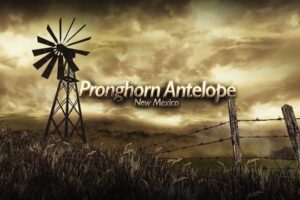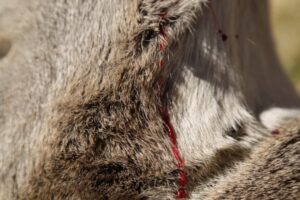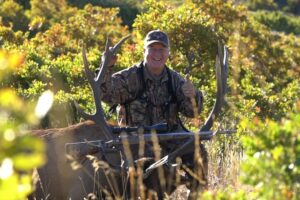2008 didn’t start off well in the western states. The months of January and February produced record-breaking snow depths in parts of Colorado, Idaho, Utah, and Wyoming. This excessive snow was very hard on all the wildlife, but in particularly on the mule deer and antelope herds. Some areas lost over 50% of their populations and in northern Utah on a couple of our ranches we feel like we may have lost as much as 35% of our mule deer herd. The elk were also not immune to the long cold winter and due to their very poor physical condition going into the spring, the bulls had to put all their energy into recovering physically and little energy into antler growth. This resulted in the overall average scores of our bulls being down 15 to 20 inches. However, despite the harsh winter we feel very fortunate and know that things could have been worse. With the cooperation of landowners and manpower provided by our staff and other outfitters we were able to put together a feeding program for the mule deer on their “extreme” winter ranges. This required literally hundreds of hours in volunteer labor and although we did lose some animals, we feel as though we did do some good, and that the outcome would have been significantly worse had we not made the effort. (If you would like to view some photos of the feeding in action you can go to our gallery and look under “Camp Life”.) Now, with that being said and as dismal as I have painted this picture, Bucks & Bulls® was still able to have a very successful year, especially on top-end trophies.
Spring arrived late in New Mexico this year and it seemed as though many of the bucks lacked length and mass below the prong, however, our antelope hunts still kicked the season off well with eight of our hunters taking bucks that qualified for Boone & Crockett’s all-time listing. Several of these bucks were16” or better with the longest buck being 17 ½”. The largest buck scored 88 B&C points and was taken by long-time friend and client Mr. Dennis Sites. Although this monster antelope was barely 15” long, what he lacked in length he more than made up for in mass and prongs, with over 46” of total mass measurements and 6” prongs, this awesome pronghorn places well into the record books. Due to the dry cold spring our average was slightly lower than it has been for the last several years, but it was still an incredible 82 3/8 B&C points. Our 2009 forecast is very optimistic. In July it started raining and didn’t stop until mid August. The ranch was greener than we have ever seen it and with all the existing feed we feel that next year should be great. We also left a couple bucks that we feel could be really big in 2009 – can’t wait to get out there and find ‘em!
In our 2007 report we mentioned that we had high expectations for our 2008 elk hunts because of all the moisture that we were receiving at the time the report was posted; well I am sure we are all familiar with the phrase, “Can’t get too much of a good thing,” well that’s not true in this case. As previously mentioned, too much snow and moisture can be a bad thing (Hint: Utah is a high desert therefore moisture is usually a really good thing) and it was reflected in our 2008 averages. On one ranch our average was down 20” and on another ranch our average was down almost 15” from what they have been the previous five years. Our average age remained the same that it has been for years, but they just didn’t grow the antler like they normally do in a year with an average winter; having said that, 2008 still produced some great top-end bulls, just not the in the quantity of years past. For example, client Robert Jenkins and guide Kim Bonnett connected on a beautiful 388 B&C point bull making the all-time record book, Jim Coleman and several other clients were able to harvest bulls over 350 B&C points. So how do we feel about 2009? At this point, we are having an average winter, the animals went into the winter in incredible condition, and we feel that our antler growth for 2009 will be right back to where it has been the previous five years.
The mule deer species, holistically speaking, are at a critical point on their historical time-line and unless some changes take place, a big mule deer buck could become a thing of the past, to some extent it already is. Mule deer are a fragile species and few landowners or states are willing to properly manage in order to optimize trophy potential, thus making it more difficult to find a true trophy class mule deer hunt with each passing year. Fortunately, we have landowners who are disposed to manage for top-quality bucks and put the resource first. In conjunction with this last winterkill, our landowners have been willing to cut back on the number of buck permits to ensure we don’t over harvest. In the short run this will hurt the landowner, however they are able to look at the bigger picture and understand that if they don’t make some changes today, they won’t have a resource tomorrow. Having said that, we are very fortunate to be able to offer, what we feel, are true trophy class mule deer hunts.
Several of our ranches produced excellent trophy class bucks in 2008 and the average age on one particular ranch was higher than any previous year. This is encouraging and a good indicator that the age structure is sound and that the ranch is being properly managed to sustain the future production of big bucks. This past season we were fortunate enough to harvest several bucks that scored over 190 B&C points. For more details about our 2008 mule deer harvest please give us a call. All in all, despite the 2007/2008 winterkill, our mule deer hunts went well. Numbers are definitely down on a couple of our ranches but our age structure appears to be decent and we did see some good up-and-comers for 2009.




